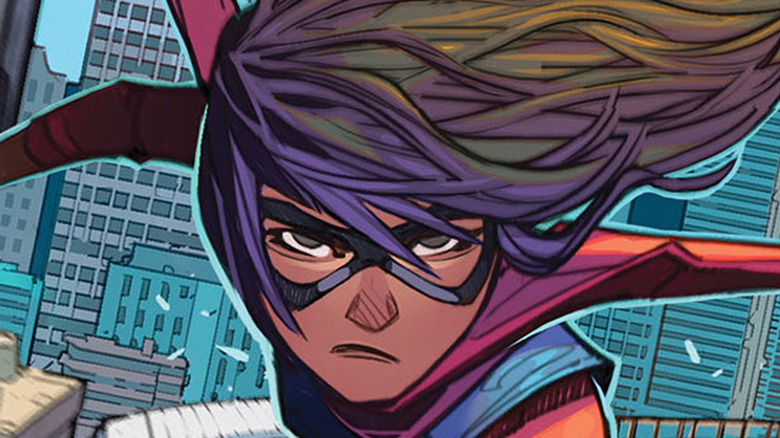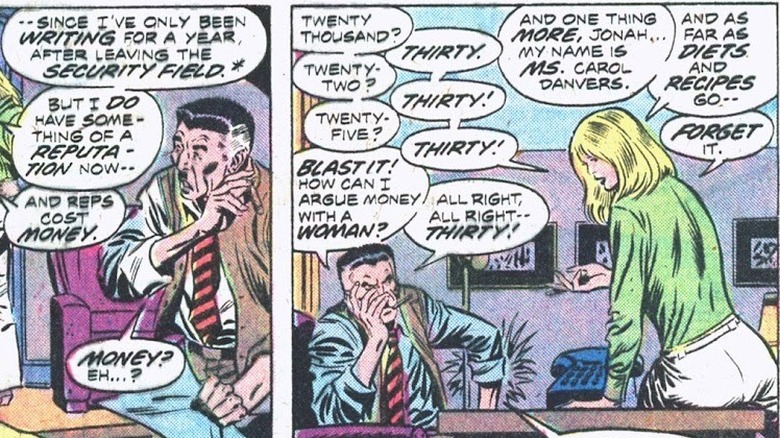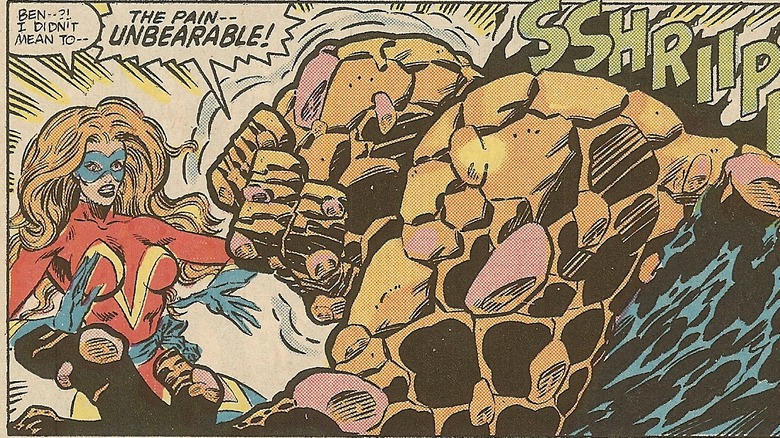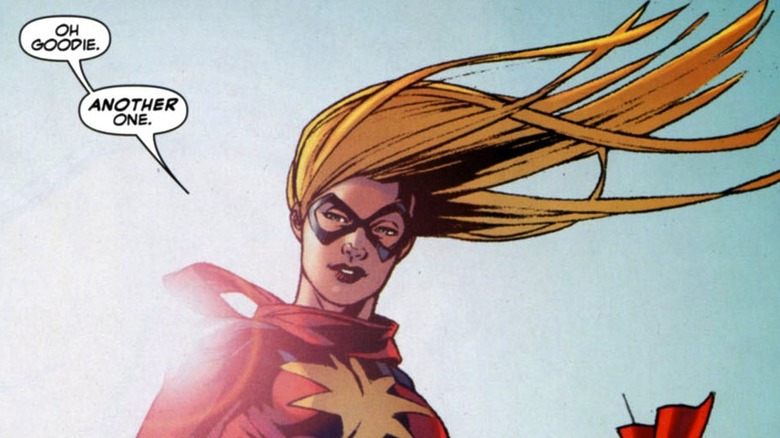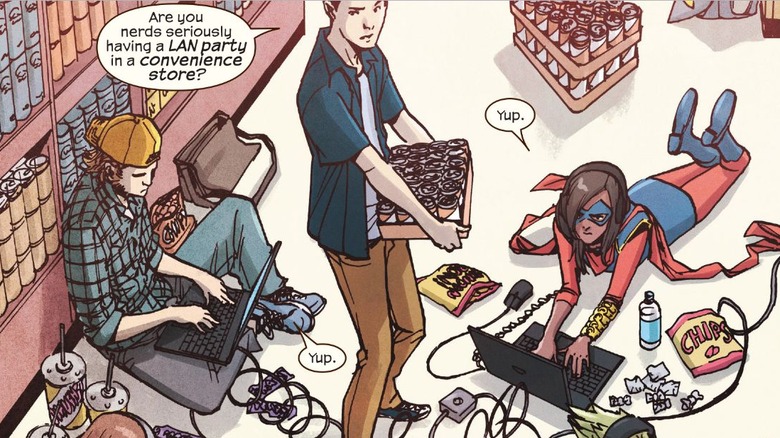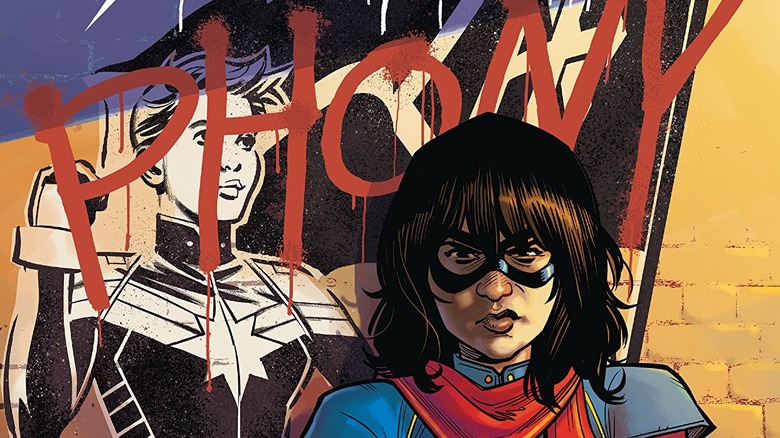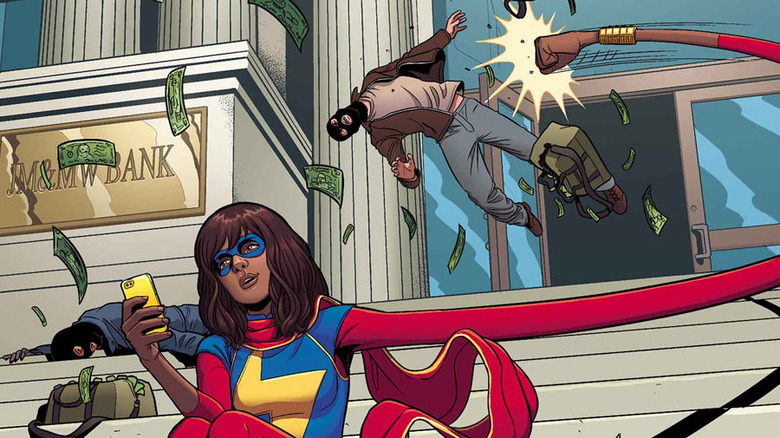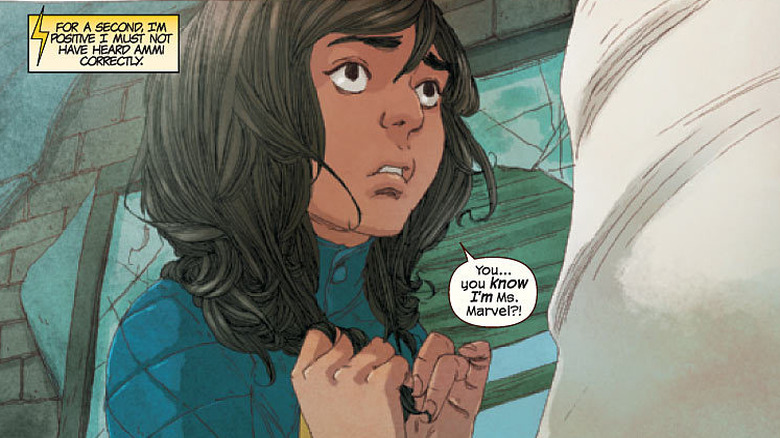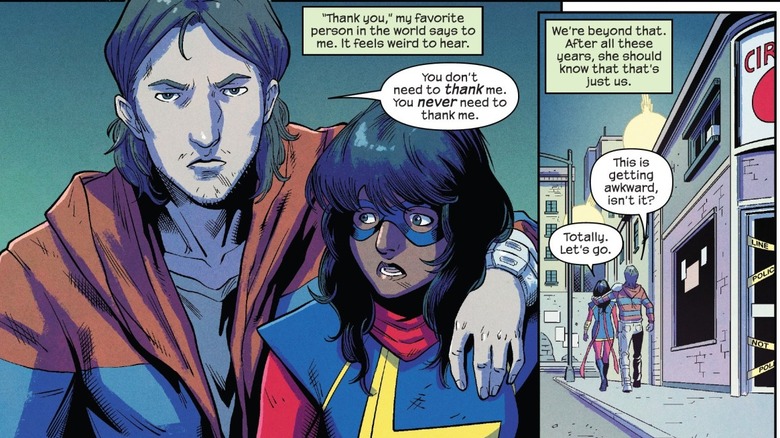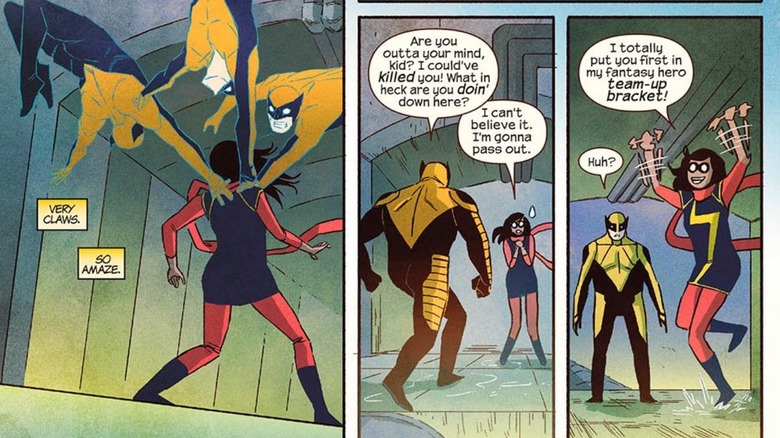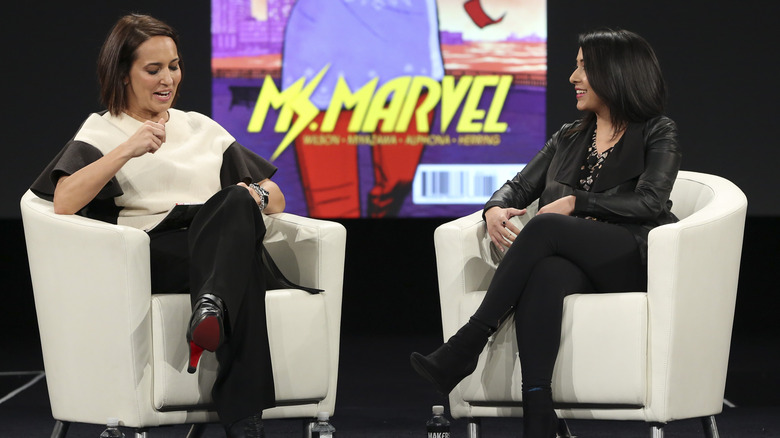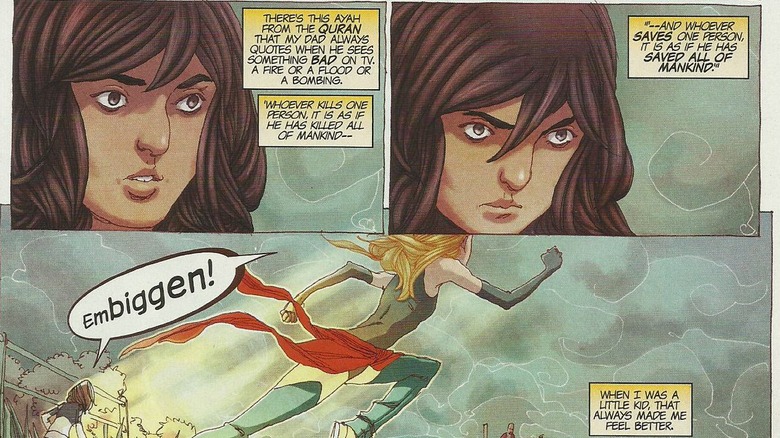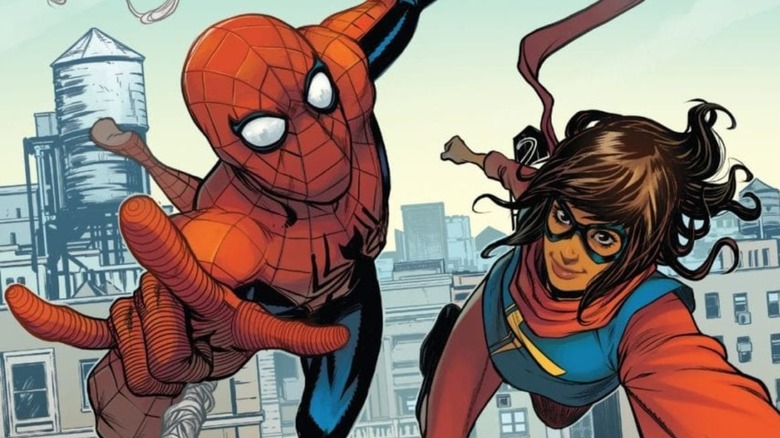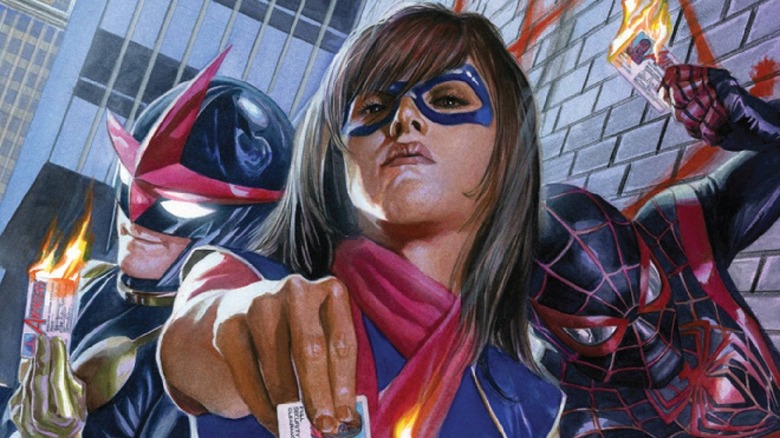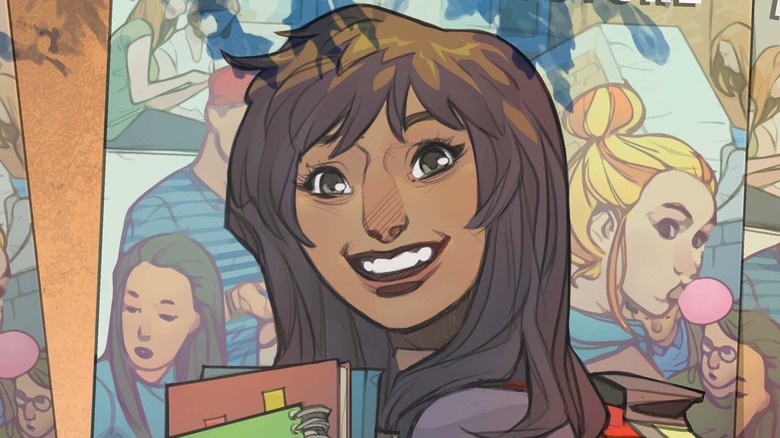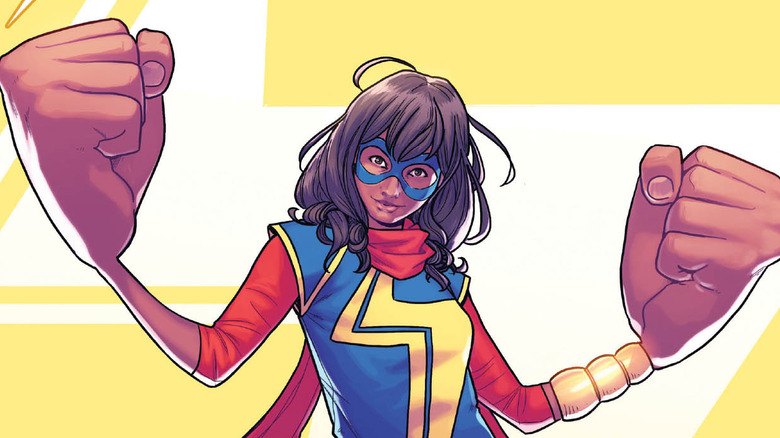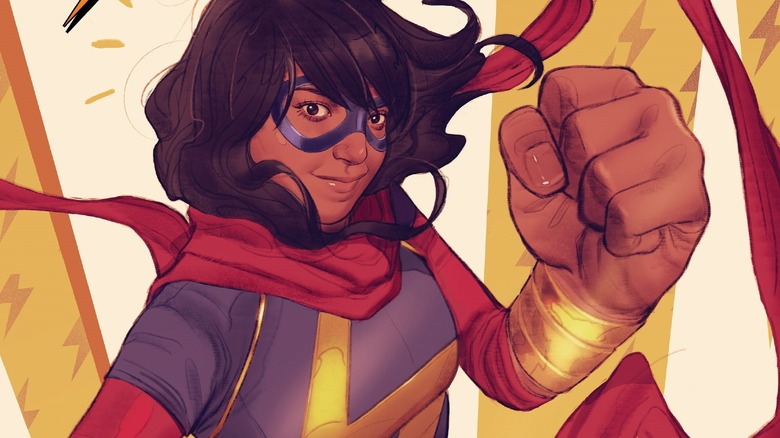The Untold Truth Of Ms. Marvel
Captain Marvel has conquered the world. From her solo debut to her brief but scene-stealing turn in "Avengers: Endgame," the whole world knows about Carol Danvers and all that she can do. Photon blasts? Ace piloting? Killer karaoke? She's the woman for the job — and in the post-"Endgame" MCU, she is poised to become one of the monumental franchise's leading lights.
But Carol wasn't always Captain Marvel. Once, she was known as Ms. Marvel, and now that name has passed to another: Kamala Khan, Jersey City's own girl wonder, armed with the power of shapeshifting and devastating Gen-Z sass. But just what does it mean to be Ms. Marvel? And what, with her set to star in a Disney+ streaming series, makes Kamala so worthy of the title? A lot, it turns out, from her gaming skills to her surprisingly robust history of team-ups. Join us as we explore the past and present of Ms. Marvel, with an eye towards the shape-changing, level-grinding, dynamically-embiggening future.
Gloria Steinem with superpowers
The first Ms. Marvel was actually Carol Danvers. Long before she traded in her leotards for a flight suit, she was fighting for equal pay and military respect in her 1977 self-titled solo series. The use of "Ms." as opposed to "Mrs." or "Miss," was purposefully aligned with the contemporary feminist movement's celebration of the title as an identifier of women unto themselves, with or without a man. This was even more explicit in the stories themselves — though fans today know her best as an ace pilot who drinks hard and lives to surpass her own records, Carol spent much of the late 1970s as a Gloria Steinem type, breaking down barriers in publishing and public discourse as the editor of WOMAN Magazine.
Originally hired by the one and only J. Jonah Jameson as a replacement for the allegedly strident former editor, Carol kicked off her reign at WOMAN by... being openly feminist and putting herself as Ms. Marvel on the cover. Though her tenure at the magazine was ultimately brief, its legacy remains. The 2012 issue of "Captain Marvel" that debuted her new name found Carol caring for one of her former WOMAN colleagues — thus establishing her new primacy in the Marvel Universe as rooted in her 1970s convictions.
Ms. Marvel enters the ring
Carol isn't the only woman to have stepped into Ms. Marvel's boots, however. 1986 saw a brand new Ms. Marvel in the character of Sharon Ventura, and her path was a strange one indeed. Originally part of the super-powered wrestling circuit, Sharon took on the title of Ms. Marvel to better rope in fans. Yet all was not well — the Unlimited Class Wrestling Federation she joined hooked its wrestlers on addictive substances that boosted their strength.
Breaking free of the UCWF wasn't the end of her woes, however. After joining the Fantastic Four, Sharon was exposed to the same cosmic rays that altered the famous foursome, transforming her from a lithe beauty into an orange rock monster, much like the Thing. This was a terrible blow that struck to the very core of her self esteem. Yet she rallied, becoming better known as She-Thing than she ever was as Ms. Marvel. Though she only claimed the title for a short while (and in the ring far more often than on the streets) her confidence, prowess, and adaptability did the moniker proud.
Ms. Marvel and the Dark Avengers
Not all who have called themselves Ms. Marvel have been eager to make the world a better place. One woman in particular, Dr. Karla Sofen, is an inveterate evil-doer who took on the name as part of the 2000s "Dark Avengers" storyline. A psychologist who manipulates one of her patients into handing over the gem that gives him — and, subsequently, her — fabulous powers, Sofen's abilities, much like Carol's, come from Kree technology, in the form of a gravity-altering stone.
Typically known as Moonstone, she's responsible for acts like needling her patients into self-harm and murdering her own mother — though she has, at times, flirted with goodness. This got complicated when, in 2009, she joined Norman Osborn's Dark Avengers. A brutal team who quelled unrest by any means necessary, they lived up to their name until things, predictably, became complicated. In the end, Karla went back to being Moonstone, and another villainess, Superia, took up the mantle for a time. When last we saw her, Moonstone was back to her old tricks and a member of appropriately named Masters of Evil. There are some ne'er-do-wells not even the allure of being Ms. Marvel can redeem.
Superpowered nerd
Finally, after years of Marvel playing musical capes with the Ms. Marvel title, Kamala Khan arrived. Debuting in 2014's "Ms. Marvel" #1, Kamala was an immediate sensation. A young Pakistani American teenager from Jersey City, she's a hardcore superhero fangirl, a lover of her local hot dog stand's "Doom Dogs," and an unstoppable believer in doing the right thing. Readers loved her from the very beginning as a kind-hearted, whip-smart, utterly modern incarnation of the classic Marvel spirit.
There is one attribute that defines Kamala more than any other, however: she is an absolutely enormous nerd. We're talking the kind of girl who tells Wolverine, upon meeting him, that her "Wolverine-and-Storm-in-space fanfic was the third-most upvoted story on Freaking Awesome last month!" The kind of kid who is more likely to put off homework for a World of Battlecraft raid than an illicit liaison. The sort of superhero who tracks down a bad guy who might be stalking his guildmates. In her devotion to nerdery, Kamala isn't just a believable teen of today — she's a celebration of geeky girls everywhere. Kamala's passion for superheroes and fantasy doesn't just entertain her, it fuels her in her undying mission to protect the world she loves. One question lingers, however: Does Kamala read the fanfic others write about her?
A rift between Carol and Kamala
If there's one primary object of Kamala's fangirlishness, it's her predecessor, Carol Danvers. Kamala is utterly devoted to Carol, explicitly having taken on the mantle of Ms. Marvel in a tribute to her idol. The 2015 "Last Days" storyline of the Secret Wars event finally brought Kamala and Carol together in preparation for an apocalypse that was thankfully averted. After a brief explosion of excitement, Kamala calmed down, and the duo worked to protect the frantic citizens of Jersey City. Carol left Kamala with a pendant, emblazoned with her star and Kamala's lightning bolt, that would alert her in case of trouble. The love and respect between the two was sealed — a reciprocal relationship now that they had met, rather than a one-sided adoration.
Yet all did not remain well between the two. The "Civil War II" event saw Kamala split with Carol when the latter used the precognitive abilities of an Inhuman named Ulysses to administer brutal justice. When Ulysses predicted a violent attack from Kamala's classmate Josh, Kamala went to his home and found a confused young man with only the possibility of violence within him. Unable to punish people for actions they had not taken, Kamala split with her idol — and everything she then stood for.
Best-selling status
Reviews have been strong for Kamala's series ever since the beginning. But critical adoration doesn't always translate into success — witness the odd journey of the award-winning "Gotham Central" series, which garnered awards and adulation but repeatedly failed to crack the top-100 sales chart. So it goes for many critical darlings: they reap a bounty of gushing praise, yet struggle to make any actual money.
Fortunately, this has not been the case for Ms. Marvel. Since the very beginning of her solo series, Kamala has been as bankable as she has been beloved, a stone-cold success story that moves books off shelves at a steady clip. The first volume of "Ms. Marvel," entitled "No Normal," collected the first five issues of the series and became the best-selling graphic novel of October 2014, the month it debuted. In today's book market, Kamala's up against some stiff competition — publishers everywhere know that kids are hungry for comics. But Kamala has bested them all, remaining a strong seller whose new volumes regularly debut on the New York Times Best Sellers List. In a world where voting with one's dollar often matters most, Kamala is riding high.
A not-so-secret identity
Secret identities are the bread and butter of superhero stories. No one can know Spider-Man's everyday life as Peter Parker, lest they target his loved ones. Bruce Wayne keeps his life as an internationally renowned playboy decidedly separate from his nighttime jaunts across the rooftops of Gotham City. Superman manages to fool the public with a sturdy set of eyeglasses and a pleasantly unassuming Midwestern affect.
Kamala tried this, for a while. And she managed to succeed for a good long time, save for her best friend Bruno, who's been helping her in her mission from the beginning. But when the end of the world was nigh during the "Last Days" story arc, Kamala told her mother about her life as Ms. Marvel... only to discover that her mother already knew. As she told her shocked daughter, Muneeba Khan is proud to have raised a "righteous child," and though she worries about the danger Kamala is so frequently put in, she supports Kamala's choices. After this revelation, the dominoes quickly fell, and now both of Kamala's parents know about her superheroic side-job. In fact, a recent story took all three of them to the far reaches of space.
Love among the lockers
Kamala is nerd, a superhero, a capable student, and a fairly impressive ad-hoc costume designer. But before she is any of those impressive things, she is a teenager. And there's nothing that defines the teenage experience quite like first love.
Bruno Carrelli is Kamala's love interest, but their path has hardly run smooth. A brilliant young scientist, he and Kamala met as young children, grew up together, and now attend Coles Academic High School when they're not combining Bruno's brains with Kamala's shapeshifting to take down all who threaten Jersey City. Bruno, obviously besotted with his best friend from the beginning, struggles to admit his feelings, and ends up dating another girl, Mike, while Kamala explores her interest in boys she's met among the cape-and-cowl set.
What lies between them was brutally battered when Bruno was permanently disabled in an explosion during the "Civil War II" storyline. Still reeling, he traveled to Wakanda to study as a scholarship student and put some much-needed space between him and the girl he can't quite seem to stop loving. What lies ahead for Bruno and Kamala? Well, a recent issue saw Bruno peering into one of many possible futures, in which he and Kamala marry. Hope springs eternal — especially for lovelorn teenagers.
Team-ups galore
Kamala's been around for roughly five years — an eyeblink in superhero time, compared to characters like Namor and the Human Torch, who hail from 1939. Yet those scant five years have contained an absolutely dizzying number of team-ups, crossovers, and partnerships. Kamala hasn't made her way around the Marvel Universe and its sundry heroes, villains, and planet-eating gods so much as she's conquered it.
Uniquely for such a new character, Kamala tends to set the tone for her adventures alongside older, more established heroes. When she fights alongside Wolverine, they prowl the sewers, discuss the most popular Avengers fanfic, and, in a moment Wolverine swears Kamala to secrecy about, cross a canal with the teen wonder carrying the formidable X-Man on piggy-back. In a moment of admiration, Wolverine even stops himself from cursing in front of Kamala, amending his words into an utterance of "crazy sh–some crazy stuff."
Later, Kamala crossed paths with Loki, who... crashed her high school's Valentines dance. Did cosmic hijinks ensue? Well, not really. The god of mischief spiked the punch with Asgardian truth serum and failed to get Bruno to confess his feelings. Denizens of the Marvel Universe beware: if you're on Kamala's turf, you will end up playing by her rules.
Kamala's prodigious impact
Kamala's changed the world more than a few times at this point. But it's not just her fictional realm that's been affected by her stalwart courage and confidence — it's our very own real world, too. First, of course, there were the ripples caused by the announcement of her imminent arrival in the Marvel Universe. Commentators celebrated such a fresh new face, and hailed her as a win for representation of marginalized people. This praise escalated steadily as her comics continued to garner sterling reviews and strong sales, culminating in a visit to the White House in 2016. There, at a reception for Women's History Month, Marvel editor Sana Amanat presented President Obama with a copy of "Ms. Marvel" Vol. 1, and spoke to Kamala's significance within the modern world.
But not all of Kamala's real-world impact has happened in the halls of power. 2015 saw Kamala's image on San Francisco buses, covering up Islamophobic ads that equated Islam with Nazism. In the guerrilla art campaign, Kamala grinned next to slogans like "Calling all Bigotry Busters" and "Stamp Out Racism." Kamala co-creator G. Willow Wilson herself commended the campaign, praising the artists as "amazing." Starting conversations in the White House and the city streets? It's all in a day's work for Kamala Khan.
Merriam-Webster cosigns Kamala
Language is a fluid thing. It was only a scant few decades ago, after all, that terms like "Googling" and "blogosphere" would have gotten someone blank stares and suspicions of lunacy. Comic books have been a part of this ever-changing tradition for quite a while: The word "superhero" itself is only a little over a century old, having started with "The Scarlet Pimpernel" and come into full flower with the advent of the Golden Age of comics. Nowadays, autocorrect knows words like "Kryptonite" and the average man on the street knows what a "thought bubble" is.
Much as she's irrevocably changed the Marvel Universe, Kamala has already impacted the world of language. In 2018, Merriam-Webster added the word "embiggen" to its dictionary, declaring it (among 850 others) a "real" word. Though a 1996 episode of "The Simpsons" was the first to coin the phrase, Kamala's use of it to describe her powers — she frequently yells it as she stretches herself into greater stature — was likely part of its path to respect, indicated especially by Merriam-Webster's tweet linking the word to a gif of Kamala. The linguistic authority defines it as a transitive verb, meaning "to make bigger or more expansive," and as informal and humorous. Despite the seriousness of her cause, Kamala is indeed beloved for taking her duties with a certain sunniness. Now, that good cheer has been immortalized in the annals of the English language.
Kamala Khan and the OG Spider-Man
As a huge fan of superheroes in general (and perhaps the biggest fan of Carol Danvers in the Marvel Universe), there's no doubt that Kamala Khan enjoyed the opportunities she had to work with Earth's costumed greats. Interestingly, some of her most notable team-ups have been with a Marvel legend who started out as an anxious yet determined teenage crime-fighter himself: Spider-Man.
Ms. Marvel and Spidey first officially teamed up in "Amazing Spider-Man" Vol. 3 #7 to stop Kree scientist Dr. Minerva from harnessing the powers of a genetically enhanced baby to build an army of Kree supersoldiers. Kamala arrives on the scene first, but is easily outmaneuvered by the blue-skinned supervillain. Fortunately, Spider-Man arrives just in time to lend the fledgling superhero a hand. And like any true fangirl would, Kamala promptly geeks out at the prospect of being in a "Spider-Man team-up," immediately bombarding the webslinger with questions about his dating history with Danvers (much to his chagrin). After their adventure, Spider-Man tells Kamala that she reminds him of how he was when he was younger, and reassures her that she's doing just fine.
A significant development in their relationship takes place in the first arc of "Marvel Team-Up" Vol. 4, when a science demonstration gone awry causes Spider-Man and Ms. Marvel to temporarily switch bodies. They subsequently learn each other's secret identities, and develop mutual trust and respect as they figure out how to return to their own bodies.
Leading the Champions
One can imagine that for a big superhero fan, becoming a superhero would be the greatest thing ever. The only thing better than that would be to become a superhero and earn membership to the super-team of super-teams: The Avengers. For Kamala Khan, that's exactly what happened. She and fellow young heroes Spider-Man (Miles Morales) and Nova (Sam Alexander) joined the ranks of the Avengers alongside veterans like Captain America (Sam Wilson), Thor (Jane Foster), and the Vision. Unfortunately, this dream was not meant to last for the three costumed teenagers — but what followed was arguably an even bigger highlight for their collective careers.
In 2016's "Champions" Vol. 2 #1, we see part of the aftermath of the second superhuman Civil War. Already disillusioned by the actions of her idol Captain Marvel, her frustration with the adult superhero community reached its peak during a mission. Wanting to be more proactive in fixing the damage that their super-powered brawls tend to cause, Ms. Marvel quits the team after Captain America shoots down her suggestion to fix the train tracks they had just wrecked. She stops her superhero activities for a few days, but eventually reaches out to Nova and Spider-Man (who already quit before she did). She then proposes an idea: A team of newer heroes who'll fix everything their more experienced peers broke during their "dumb war." Soon, the Hulk (Amadeus Cho), Viv Vision, and a time-traveling Cyclops join the newly formed Champions under her leadership.
Kamala's Law
The idea of individuals with super-powers dressing up to fight evil has long been a sore point in the Marvel Universe, despite the countless times they've saved the world and even the universe with their actions. It tends to become an even bigger problem when the discussion shifts to the idea of inexperienced young superheroes with no formal training (just ask the OG Spider-Man, who'll likely have plenty of stories to tell about his youthful brushes with the law and the media). The Champions, especially Ms. Marvel, found themselves at the center of this issue in 2020's "Outlawed" Vol. 1 #1. A standoff at Coles Academic High School involving the super-team renders the stretchy heroine hospitalized in her civilian identity — and also led to the passing of an underage superhero ban that lawmakers unwittingly named after the superhero they held partially responsible for it.
In their efforts to protect a climate activist named Ailana Kabua from an attack by the Roxxon Energy Corporation, an unfortunate incident involving Viv Vision and the new Power Man (Víctor Álvarez) accidentally causes a building to collapse. While still out of costume, Kamala protects Ailana with her body, but is rendered comatose. This prompts Senator Geoffrey Patrick to pass the Underage Superhuman Welfare Act, which was named Kamala's Law to honor her. The Champions resist, choosing to fight for their right to operate as superheroes. Eventually, Kamala's Law is repealed (and the true villains revealed) thanks to their efforts.
Progress or tokenism?
Kamala Khan is typically hailed as a groundbreaking superhero in the media, being the first Muslim character in Marvel Comics to star in a self-titled book. However, researchers at the London School of Economics and Political Science's Middle East Centre have raised some valid questions: Is Ms. Marvel truly a sign of positive social change, or simply a marketing stunt? More importantly, does the character have any real cross-cultural impact on how the public perceives identity? In talking to participants from Beirut, London, and Singapore, the authors found that Marvel's "move to greater diversity" with the introduction of Kamala Khan was generally interpreted in two ways. Some see it as a means of building better cultural understanding and breaking down "majority-minority tensions," while others think that it's nothing more than a "tokenistic gesture" by a multibillion-dollar entertainment company.
It's undeniable that the young Ms. Marvel does, to a significant degree, represent a welcome change in the Western entertainment landscape when it comes to non-stereotypical representation of different cultures. Redefy notes the obvious similarities between Kamala and Peter Parker, with both of them being portrayed as "regular middle-class urban teenager[s] saving the day." In Kamala's case, her being a Muslim is not used to define the core of her character, nor is it portrayed as an obstacle that prevents her from becoming the best version of herself. Regardless of Marvel's motives, the push towards diversity is a welcome one.
Why did the showrunners change Ms. Marvel's origin story?
While the formal announcement of Kamala Khan becoming a part of the MCU was certainly pleasant news to her many fans, there's one core aspect of her character that got changed in her transition from the page to the screen. In the comics, Kamala's dormant Inhuman abilities are unlocked following her exposure to the Terrigen Mists. She has both stretching abilities akin to Mr. Fantastic's and size-changing powers like Ant-Man. In addition, she is a shapeshifter with a (limited) healing factor. On the other hand, her live-action counterpart (portrayed by Iman Vellani) possesses thought-based light construct powers — somewhat like Green Lantern's, but purple — which she discovered after wearing an old bangle belonging to her family.
Why did the creators of the Disney+ show decide to alter Ms. Marvel's power set and origin story so drastically? In an interview with Decider, the show's head writer Bisha K. Ali stated that in the interest of efficient storytelling, they left out elements involving the Terrigen Mists and the Inhumans in favor of giving Kamala a "streamlined origin." Additionally, the character's co-creator and show executive producer Sana Amanat shed more light (pun absolutely intended) on how Kamala obtains "hard light" abilities on the show. "[Bisha and her team] expanded on [the idea of the bangle] and said, 'What if that is the source of how she gets her powers?' To me that was so beautiful, because ultimately this story is one about identity. And linking the bangle to her family and to the root of her power is a really powerful statement."
